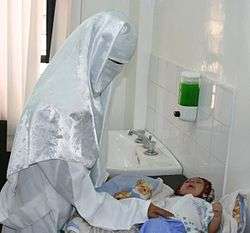Health in Yemen
Despite the significant progress Yemen has made to expand and improve its health care system over the past decade, the system remains severely underdeveloped. Total expenditures on health care in 2002 constituted 3.7 percent of gross domestic product.[1]

In that same year, the per capita expenditure for health care was very low, as compared with other Middle Eastern countries—US$58 according to United Nations statistics and US$23 according to the World Health Organization. According to the World Bank, the number of doctors in Yemen rose by an average of more than 7 percent between 1995 and 2000, but as of 2004 there were still only three doctors per 10,000 persons. In 2003 Yemen had only 0.6 hospital beds available per 1,000 persons.[1]
Health care services are particularly scarce in rural areas. Only 25 percent of rural areas are covered by health services, as compared with 80 percent of urban areas. Emergency services, such as ambulance service and blood banks, are non-existent.[1]
Health status
HIV/AIDS
According to the Joint United Nations Programme on HIV/AIDS, in 2003 an estimated 12,000 people in Yemen were living with HIV/AIDS.[1]
Maternal and Child Health Care
The 2010 maternal mortality rate per 100,000 births for Yemen is 210. This is compared with 268.7 in 2008 and 582.4 in 1990. The under 5 mortality rate, per 1,000 births is 70 and the neonatal mortality as a percentage of under 5's mortality is 44. In Yemen the number of midwives per 1,000 live births is 5 and the lifetime risk of death for pregnant women is 1 in 91.[2] Most childhood deaths are caused by illnesses for which vaccines exist or that are otherwise preventable.[1]
See also
External links
References
- Yemen country profile. Library of Congress Federal Research Division (December 2006). This article incorporates text from this source, which is in the public domain.
- "The State Of The World's Midwifery". United Nations Population Fund. Retrieved August 2011. Check date values in:
|accessdate=(help)